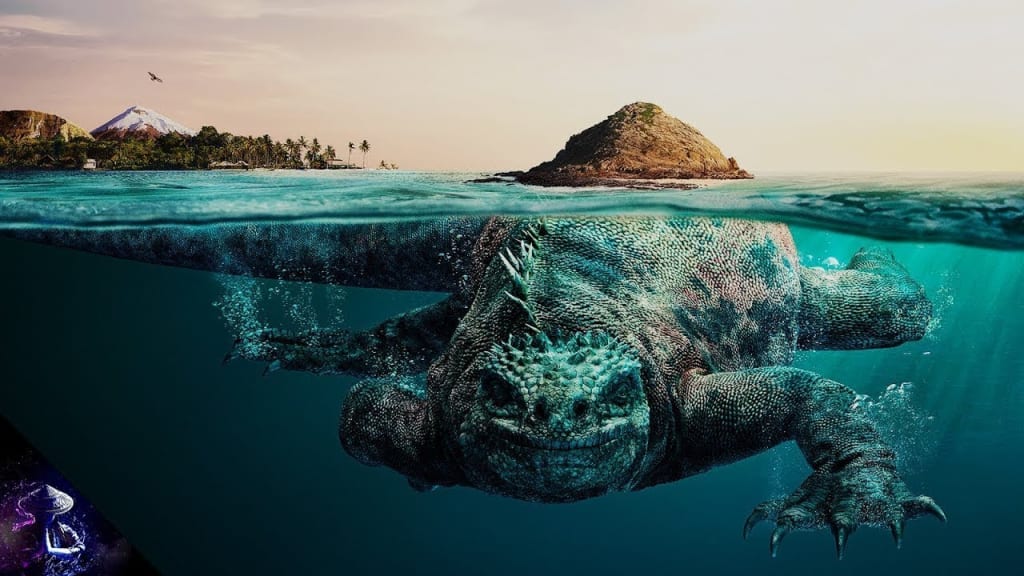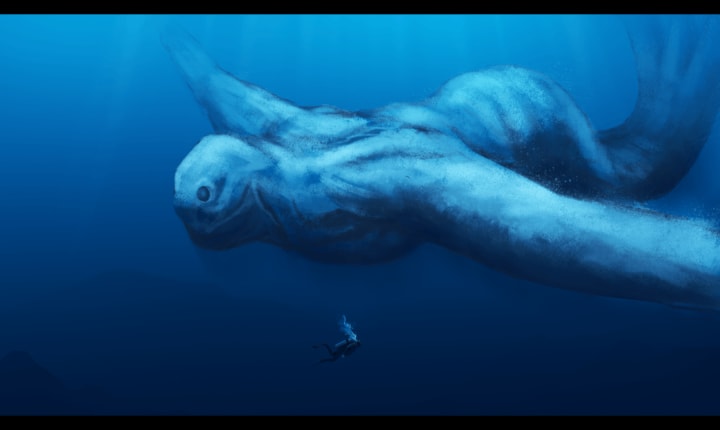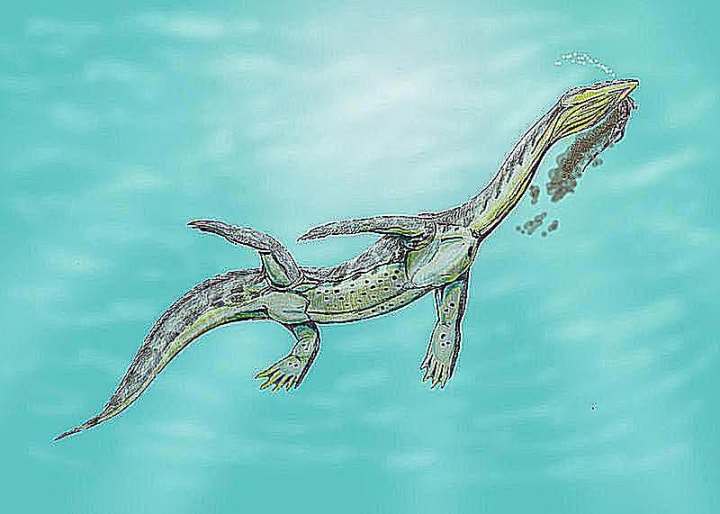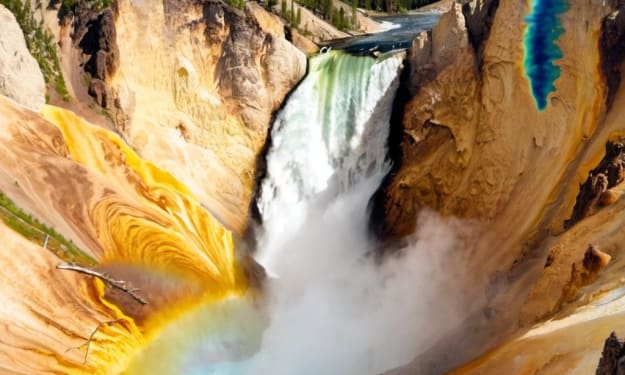8 Mysterious Deep Sea Creatures Spotted On Google Earth
Data from factfile YouTube channel

One of the top navigational apps in the world over time is Google Maps. Using your smartphone or computer, you can quickly plan road trips, find faster routes through traffic, or view nearly anywhere on the planet.
But, there are some things you simply can't expect to see while utilizing or experimenting with Google Maps, such as viewing the historic 9/11 assaults or perhaps discovering a long-lost monster that can instantly consume you.
In light of this, we present to you today a list of the ten most puzzling deep-sea species ever discovered by Google Earth. Although some of the animals on this list might seem too fantastic to be true, they were observed. You had better pay attention if you wanted to learn what they were. After all, only 3% of our seas have been studied by scientists, leaving many more mysteries to be solved. Why don't we have a look?
1., The Giant Spider in Mexico:

Do you still have any memories of the made-up Aragog from Harry Potter and the Chamber of Secrets? He might might be genuine after all, as MexicoGeek, a YouTube user, claimed to have discovered a gigantic spider on an island off the coast of Mexico.
He initially didn't think much of the strangely shaped object that appeared to be an arthropod until he used a Google ruler to determine that it was actually roughly the size of a bus. And a beast of that magnitude is capable of consuming an adult human. Blimey!
As other users cannot view the precise coordinates on Google Maps, several people have asserted that it is a scam. The phenomenon known as pareidolia, which occurs when we interpret shapes based on imagination, prompted some experts to speculate that it was likely a build-up of algae that seemed as an arachnid at such a distance from the satellite.
Yet, the photograph unmistakably appeared authentic, and it remains a question as to whether or not the picture is a fraud.
2., The Crabzilla in British Water:

The Weird Whitstable blog's creator, Winter Quinton, shared a screenshot of Google Map with one of his fans that revealed a shrimp-like monster measuring roughly fifty feet in actual size off the coast of Whitstable harbour in Britain. Can this be done?
We have always recognised crabs to be intriguing creatures since they come in so many different types, some of which are small and others of which are very enormous, such as the Japanese spider crab, which holds the record at nearly 12 feet. Whistable is a well-known oyster palace.
The Winter's crabzilla, a crab that is around three times the size of a double-decker bus, is truly inconceivable, though. Due to the local currents, several marine biologists referred to it as a well-made put-on or possibly some strange-looking shoal.
Whatever it is that sits there, whether it's a sandbank or a crab, Google Maps shows it. We can only hope that it is not, as the source suggests, a man-eating "crabzilla," as it may terrify the living daylights out of us.
3., The Loch Ness Monster:

In Scotland, Nessie, or as it is more often known, has always been the talk of the town. Many reports of this species, which is said to resemble a snake or a plesiosaur, have been made in several locations, including near Loch Ness Lake. Due to a lack of conclusive evidence, numerous specialists have over the years refuted its existence.
Yet as things stand, it appears that the mystery has gained more traction following Lisa Stout, a 31-year-old mother from the US, who claimed to have seen Nessie on Google Maps.
Always fiddling with her phone in the hopes of spotting Nessie, Lisa allegedly struck it rich one morning after dropping her kid off at school when she allegedly caught a glimpse of an elusive monster with long necks jutting out of the lake on Google Street View in the area of Loch Ness.
Is that Nessie for real? Has the lengthy hunt for Nessie come to an end? If Nessie has been found, this mage has generated a lot of shock on the internet. What do you think, guys?
4., The Megalodon:

The gigantic killer shark species known as megalodons is said to be the most common species of shark, rising to a length of about 60 feet. Three African elephants would fit side by side in that space. Blimey! That's a lot. They lived roughly 23 million years ago, which is another detail to add to their profile.
The Megalodon was a prehistoric species of shark that lived approximately 23 to 2.6 million years ago during the Cenozoic Era. It is widely considered to be one of the largest and most powerful predators to ever exist, with some estimates suggesting that it could grow up to 60 feet (18 meters) in length and weigh over 60 tons (54 metric tonnes).
Megalodon teeth and other fossils have been found all over the world, and they provide valuable information about the size, diet, and behavior of this extinct species. Based on these fossils, scientists believe that Megalodons were apex predators that primarily hunted large marine mammals such as whales and dolphins.
Despite the popularity of the Megalodon in popular culture, including the 2018 film "The Meg," the species is extinct and has been for millions of years. The exact cause of its extinction is unclear, but it is believed to have been a combination of factors such as climate change, competition for prey, and changes in oceanic conditions.
Today, the legacy of the Megalodon lives on through its fossils and in popular culture, where it continues to be a source of fascination and intrigue for people around the world.
But, it appears they are still alive after all after a team of University of British Columbia experts found evidence of them in the Persian Gulf.
5., The Arctic Ningen:

The Arctic Ningen is a cryptid that is said to inhabit the waters and icy regions of the Arctic. The name "Ningen" is derived from the Japanese language and translates to "human-like". The creature is reportedly human-like in appearance, with a pale white or light grey skin, and a smooth, featureless face. It is said to be incredibly large, measuring anywhere from 20 to 30 meters in length.
The first alleged sighting of the Arctic Ningen occurred in the early 2000s, when crew members of a Japanese whale research vessel claimed to have seen a humanoid creature swimming in the icy waters near Antarctica. According to the reports, the creature was completely white and appeared to be covered in fur. It had an elongated, humanoid shape, but no visible facial features. Since then, there have been several reported sightings of the Arctic Ningen, although none of these sightings have been verified.
Skeptics believe that the sightings of the Arctic Ningen may be attributed to misidentification of known marine animals, such as large whales or seals. Others suggest that the creature is simply a hoax or a creation of the imagination.
Despite the lack of concrete evidence, the legend of the Arctic Ningen has gained a following among cryptozoologists and enthusiasts of the paranormal. Some have even speculated that the creature may be a remnant of a prehistoric species that has managed to survive in the harsh, remote regions of the Arctic. However, without any verifiable evidence, the existence of the Arctic Ningen remains shrouded in mystery and uncertainty.
6., The giant aligator:

The American alligator (Alligator mississippiensis) is the largest reptile in North America, and can grow to be over 14 feet (4.3 meters) long and weigh over 1,000 pounds (450 kilograms). While it is rare to find an alligator of this size, they are not considered to be a separate species or subspecies and are simply a variation within the same species.
There have been reports of very large alligators throughout history, some of which have been verified by wildlife officials. For example, in 2014, a record-breaking alligator measuring over 15 feet (4.6 meters) long and weighing over 1,000 pounds (450 kilograms) was captured in Alabama.
It's worth noting that stories of "giant alligators" can sometimes be exaggerated or embellished, particularly in popular media or folklore. While alligators can be dangerous to humans, they typically try to avoid contact with people and are unlikely to attack unless they feel threatened or provoked.
Overall, the American alligator is an important and fascinating species that plays an important role in the ecosystems of the southeastern United States. While there are some very large individuals, they are not considered to be a separate species or subspecies and are simply a natural variation within the same species.
7., The kraken sea monster:

The Kraken is a legendary sea monster often depicted in folklore and popular culture as a giant, tentacled creature capable of destroying ships and devouring entire crews. The origins of the Kraken myth are unclear, but it is believed to have originated in Scandinavian folklore and may have been inspired by sightings of real-life creatures such as giant squid and octopuses.
The Kraken is typically described as a massive, cephalopod-like creature with multiple long tentacles, powerful suction cups, and a beaked mouth capable of crushing prey. It is said to live in the depths of the ocean, sometimes emerging to the surface to attack ships and sailors. The Kraken's size and strength are often exaggerated in popular culture, with some depictions showing it as large enough to wrap its tentacles around an entire ship or even drag it beneath the waves.
Despite the popularity of the Kraken myth, there is no scientific evidence to suggest that such a creature exists. However, it is known that there are real-life giant squid and octopuses that can grow to impressive sizes, with some individuals measuring over 40 feet (12 meters) in length. These animals have been known to attack and damage boats and fishing equipment, although they are not considered a significant threat to humans.
Overall, the Kraken remains a fascinating and enduring legend in popular culture, even if it is unlikely to ever be proven as a real creature.
8., Dinosaur in Italian:

There is no evidence of dinosaurs currently living in Italian waters, as all known species of dinosaurs went extinct over 65 million years ago. However, Italy is known for its rich fossil record, and dinosaur fossils have been discovered throughout the country.
In particular, the Italian island of Sicily has yielded numerous dinosaur fossils, including those of small, carnivorous theropods and larger herbivorous sauropods. The region was once a part of the supercontinent of Gondwana, which included South America, Africa, and Antarctica, and the fossils found in Sicily provide important clues about the evolution and diversity of dinosaurs in this part of the world.
One notable discovery in Italy is the Scipionyx, a small carnivorous dinosaur that lived during the early Cretaceous period. Its remarkably well-preserved fossil was discovered in 1981 and is considered one of the most important dinosaur specimens ever found in Europe. The fossil has provided valuable information about the anatomy and behavior of these ancient creatures.
Overall, while there are no living dinosaurs in Italian waters, the country's rich fossil record provides a window into the past and offers important insights into the diversity and evolution of these fascinating creatures.






Comments
There are no comments for this story
Be the first to respond and start the conversation.